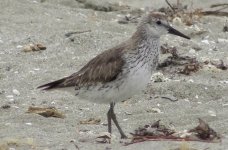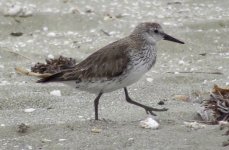-
Welcome to BirdForum, the internet's largest birding community with thousands of members from all over the world. The forums are dedicated to wild birds, birding, binoculars and equipment and all that goes with it.
Please register for an account to take part in the discussions in the forum, post your pictures in the gallery and more.
You are using an out of date browser. It may not display this or other websites correctly.
You should upgrade or use an alternative browser.
You should upgrade or use an alternative browser.
Knot not Great Knot? Western Australia (1 Viewer)
- Thread starter Wiganlad
- Start date
More options
Who Replied?Looking back at holiday video I found this fellow taken in February south of Perth on a different visit to a previous thread of mine. Is this Great knot or Knot? Any help greatly appreciated.
I think this is Red Knot. Suggest bill's too short for Great, bird doesn't have barrel-chested appearance and there's not a clear demarcation of breast from belly. Also, although there's overlap, I think supercilium is normally more pronounced on Red Knot (as here).

I think the black streaking on breast and flanks rather than greyish chevrons are much better for Great Knot than Red Knot.
I think the black streaking on breast and flanks rather than greyish chevrons are much better for Great Knot than Red Knot.
Yes could be. I initially thought was Great Knot but couldn't find any images with a bill that short.
Actually, checking Hayman, suggests that Great Knot wing tips much longer than tail. If that is what we're seeing in photo 1 then it must be Great Knot.
MJB
Well-known member
Yes could be. I initially thought was Great Knot but couldn't find any images with a bill that short.
Actually, checking Hayman, suggests that Great Knot wing tips much longer than tail. If that is what we're seeing in photo 1 then it must be Great Knot.
I think that this could be a bird hatched in the previous year, which possibly allows for continued bill growth in the following year. The species is now Endangered.
MJB
johnallcock
Well-known member
I think this is Red Knot. Suggest bill's too short for Great, bird doesn't have barrel-chested appearance and there's not a clear demarcation of breast from belly. Also, although there's overlap, I think supercilium is normally more pronounced on Red Knot (as here).
Agree with all of this. Also, Great Knot tends to have a different upperpart pattern, with dark shaft streaks and pale fringes to the mantle and scapulars.
Red Knot for me.
Agree with all of this. Also, Great Knot tends to have a different upperpart pattern, with dark shaft streaks and pale fringes to the mantle and scapulars.
Red Knot for me.
What do you think about wing length (my second comment)?
I looked through ebird red knot pics for one with the spots/streaks underneath. I couldn't find one with exactly this pattern but some were vaguely similar if less marked
johnallcock
Well-known member
What do you think about wing length (my second comment)?
It isn't something I've ever looked at before, so didn't want to comment earlier. Having looked at some photos this evening, I think the wing length on this bird (slightly longer than the tail) is in a range that could fit either species. I think the wing length is better judged on the second photo, which shows the bird in profile, rather than the first photo, which is affected by foreshortening and the fact that the left wing seems to cross over the tail.
I looked through ebird red knot pics for one with the spots/streaks underneath. I couldn't find one with exactly this pattern but some were vaguely similar if less marked
The narrow streaking on the flanks, with chevrons on the rear flanks, looks better for Red than Great to me. Great usually has fewer dark markings, which are usually larger spots or arrowheads.
Compare these two Red Knot, which I think have similar underpart patterns:
https://macaulaylibrary.org/asset/1...009.434709325.1597243881-157800393.1442389807
https://macaulaylibrary.org/asset/49816601#_ga=2.204212949.434709325.1597243881-157800393.1442389807
Look also at this photo, showing a comparison of the two species side by side. Note the difference in structure (Great with longer bill, smaller head, eye placed more centrally in head), upperpart pattern and streaking on flanks. The Red Knot here is longer-winged than the subject bird.
https://macaulaylibrary.org/asset/77158821#_ga=2.125045199.434709325.1597243881-157800393.1442389807
John_WA
Well-known member
This is a Red Knot, as John mentions above, as are the birds in the two older threads from the same area (likely the same bird as it's fairly distinctive). Key features are the shorter bill and the more evenly grey upperparts as John has mentioned, also useful are the chevrons on the lower flanks. The more well-marked facial pattern with stronger and more clearly defined pale supercilium and more obvious dark line through eye is also useful, but on this bird is not as clear as often is - possibly due to wear as it looks very worn generally.
The black patterning on the chest is somewhat atypical for Red but is not unknown. Somewhat atypical of Great also usually more splotchy dark marks in that area, but can show similar streaks
The black patterning on the chest is somewhat atypical for Red but is not unknown. Somewhat atypical of Great also usually more splotchy dark marks in that area, but can show similar streaks
John_WA
Well-known member
What do you think about wing length (my second comment)?
Is there any evidence that this is a particularly useful feature? A quick search through images of both species suggests the difference is marginal with much overlap, and I've not seen or heard it used previously?
johnallcock
Well-known member
This is a Red Knot, as John mentions above, as are the birds in the two older threads from the same area (likely the same bird as it's fairly distinctive).
Not just "likely the same bird", these are actually the same photos as on one of those threads! I'm pleased you dug them out and commented, because I'd missed them previously.
Nutcracker
Stop Brexit!
If it's all one bird - what chance a hybrid between the two? Hybrids crop up more frequently when species are endangered and can't find a mate of their own species.
johnallcock
Well-known member
I don't really see any reason to suggest this is a hybrid. The features are all within normal variation for Red Knot and there is not much to suggest any Great Knot influence.
Although both species are declining fairly rapidly, I don't think there is currently much evidence for hybridisation between them.
Although both species are declining fairly rapidly, I don't think there is currently much evidence for hybridisation between them.
Is there any evidence that this is a particularly useful feature? A quick search through images of both species suggests the difference is marginal with much overlap, and I've not seen or heard it used previously?
See Hayman et al Shorebirds plate 73: says against "adult non-breeding": "wings and tail fall roughly level" and "wings projecting noticeably beyond tail-tip" for red and great respectively
Thank you all for your invaluable comments on this bird. Although pictures were taken on 2 different visits to Tern Island, Safety Bay, WA I believe it was the same bird because he was alone and in the same area each time. As much as I would have loved it to be a Great Knot (as originally identified) it seems clear now that it is a Red Knot looking lost!
Nutcracker
Stop Brexit!
And wing tips projectling slightly beyond tail-tip on this bird . . . inconclusive!See Hayman et al Shorebirds plate 73: says against "adult non-breeding": "wings and tail fall roughly level" and "wings projecting noticeably beyond tail-tip" for red and great respectively
Deb Burhinus
Used to be well known! 😎

Just had a thought! There seem to be 3 possible sub-species of Red Knot that winter in Australasia....can anyone help me with that for my bird? I would be very grateful for any help on this.
Two sub-species
Calidris canutus piersmai and Calidris canutus rogersi. The former are slightly smaller in size and turn a darker brick red cf to a more apricot colour in the latter. There are several other differences in breeding plumage ( but once birds become worn/moult, the differences become negligible).
In Western Australia during the non-breeding season it is more likely to be C c piersmai. (C c rogersi tend to spend the winter on the East coast.)
http://www.birdskorea.org/Habitats/Yellow-Sea/China/Downloads/Birding-Asia-Red-Knot.pdf
MJB
Well-known member
Two sub-species
Calidris canutus piersmai and Calidris canutus rogersi. The former are slightly smaller in size and turn a darker brick red cf to a more apricot colour in the latter. There are several other differences in breeding plumage ( but once birds become worn/moult, the differences become negligible).
In Western Australia during the non-breeding season it is more likely to be C c piersmai. (C c rogersi tend to spend the winter on the East coast.)
http://www.birdskorea.org/Habitats/Yellow-Sea/China/Downloads/Birding-Asia-Red-Knot.pdf
Subspecies piersmai surely was named by Pavel Tomkovich in honour of Theunis Piersma's work on Red Knot...? Given the recent 'renaming' controversy, will this also be a target...?
MJB
Deb Burhinus
Used to be well known! 😎

Subspecies piersmai surely was named by Pavel Tomkovich in honour of Theunis Piersma's work on Red Knot...? Given the recent 'renaming' controversy, will this also be a target...?
MJB
I hope not, it’s getting ridiculous - there’s nothing controversial about this conservationist/ornithologist is there?. (WHO just announced diseases cant be named after people. Have we started on comets yet?!)
Users who are viewing this thread
Total: 2 (members: 0, guests: 2)





